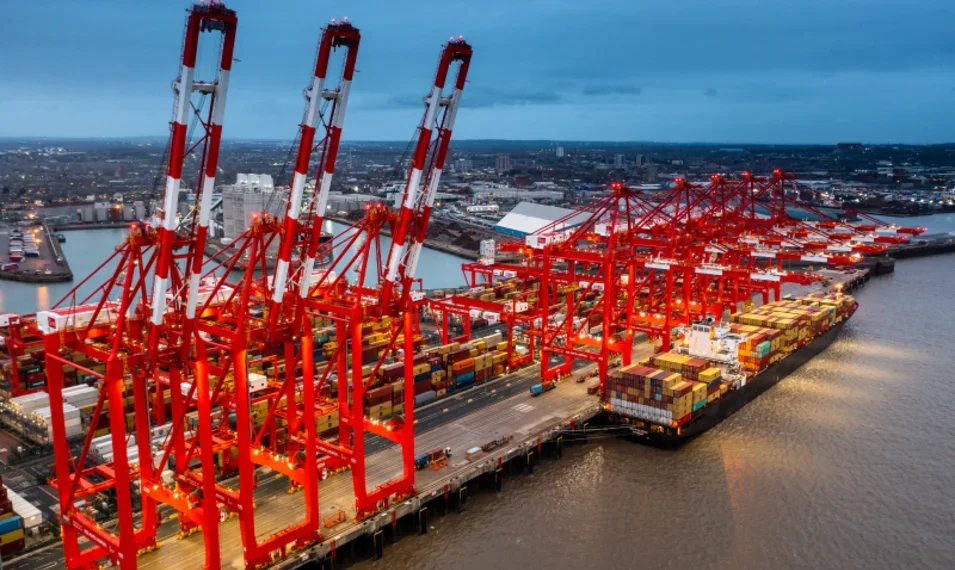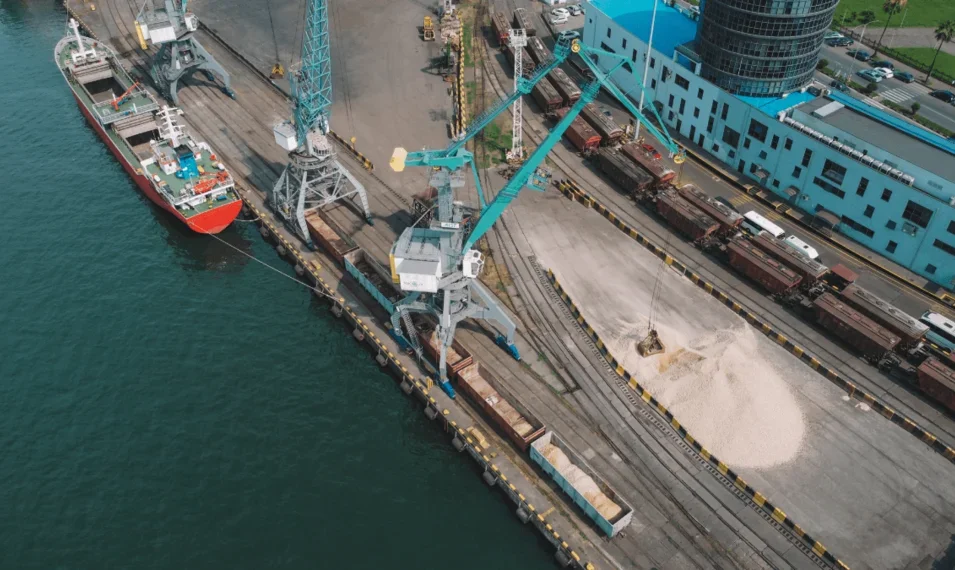
United Kingdom, Jun 5, 2025
Port infrastructure across Britain urgently requires enhanced connectivity to support the full automation of complex, end-to-end operations.
These processes are time-critical, demanding real-time precision from stakeholders. Yet, with sensitive data in play and serious risks linked to errors, upgrading legacy systems is no small task.
To modernise ageing infrastructure and ensure long-term digital security, port operators are turning to private 5G (P5G) networks as a future-ready solution. P5G offers superior coverage, capacity, and security compared to public 5G or Wi-Fi, and is highly customisable to meet industry-specific needs. The Peel Ports P5G project, part of the UK Government’s ON-SIDE initiative, exemplifies this shift. It brings together public and private sector partners, including Peel Ports Group, Logicalis UK&I, Cisco, Intel, and DSIT, to enhance operational efficiency, security, and scalability at the Port of Liverpool.
The project leverages Cisco’s cloud-managed 5G core and Nokia’s AirScale radios, managed by Logicalis, to create a robust, secure network using a lightly licensed spectrum from Ofcom. This setup allows Peel Ports to maintain full control over their network, reducing reliance on public infrastructure and enabling automation. The P5G network has been tailored to the port’s challenging environment, which consist of large metal structures and contend with constant movement, which previously hindered Wi-Fi performance.
One of the key benefits of the P5G deployment is its ability to provide seamless connectivity across the port’s vast area, including container terminals and cranes. This has significantly reduced service dropouts and cabling requirements, while improving worker safety and operational efficiency. The network supports real-time communication between straddle carriers and other port systems, enhancing logistics and data flow.
The project has already demonstrated tangible improvements, including a tenfold increase in network performance and reduced latency. Equipment has been strategically installed on existing port towers, avoiding the need for new infrastructure and promoting sustainability. The enhanced connectivity also opens the door to advanced applications like push-to-talk and man-down safety features on mobile devices.
Ultimately, the P5G network is transforming how Peel Ports operates. With the ability to deploy small, connected devices across the port, data collection and analysis have become more accessible and immediate. Daily operational meetings now benefit from real-time insights, enabling more informed decision-making and paving the way for a data-driven future in port management.
We’ve always been constrained in terms of engineering or operations, to get information or data that isn’t always easily accessible. You now have very small devices that you can deploy anywhere, to connect to a network and feed that back instantaneously. This opens the door to so much data-driven information.
Every morning, we sit in 8 o’clock meetings and look at data within our operations. This P5G network delivers this on a plate to us, directly. The amount of equipment we can fit on is now endless.
Damien Cross
Head of Containers Technology & Automation
Peel Ports Group
Download the written case study for a full account of P5G project at the Port of Liverpool.
Related Insights

United Kingdom , Oct 16, 2025
The wireless wake-up call for CIOs
Research reveals that CIOs in the UK, Ireland, and Channel Islands lag behind global peers in adopting IoT and Private 5G technologies despite budget allocations for these investments. Addressing barriers like budget, compliance, and skills is crucial for closing this gap and unlocking competitive advantages.

Guernsey , Aug 14, 2025
Building resilience and enabling smarter operations
Imperium has embarked on its digital transformation journey to help overcome the challenges of regulatory compliance and data security and to deliver services with Logicalis as its trusted IT provider.

Ireland , Jun 17, 2025
Communicating with Clarity: Breaking language barriers with AI
John Paul Construction overcame language barriers across its multinational teams by implementing Microsoft Azure AI translation services with the help of Logicalis. The solution included a custom WebApp and Copilot-assisted translations, improving communication, efficiency, and accuracy while reducing manual workload and enhancing collaboration.

United Kingdom , Apr 10, 2025
From bottlenecks to breakthroughs: How Private 5G is transforming port operations
Unlike Public 5G, Private 5G gives businesses full control over their networks, allowing them to customise their connectivity for mission-critical applications, while tightening any necessary security measures.

United Kingdom , Dec 16, 2024
Ensuring regulatory compliance and cyber resilience
With the introduction of the European Central Bank’s (ECB) Digital Operational Resilience Act (DORA), our customer, a prominent European Bank, needed to make changes to the way it stores data to keep in compliance with the regulations.

Ireland , Dec 16, 2024
Optimising Azure at scale for DCC
Watch this video case study that brings to life DCC's transformative journey to standardise their approach to Microsoft Azure across 50 businesses

United Kingdom , Oct 16, 2024
ESW tailors Security with Azure Sentinel
Global eCommerce platform ESW (eShopWorld) sought a cloud security strategy that would live up to the payment card industry’s strict compliance and governance standards. ESW partnered with Logicalis Ireland to pursue a solution that would support the modernisation of their technology and ensure adherence to PCI compliance and governance requirements.

United Kingdom , Oct 16, 2024
Jersey Electricity scale and modernise security with a managed service from Logicalis
The core of Jersey Electricity’s (JE) defence systems were centred on legacy cybersecurity log aggregation platforms. These platforms took up a lot of Security Operations Centre (SOC) man hours to manage. There was a challenge to produce meaningful reports, and vulnerability and correlation though the millions of logs took time. The security team was wasting time operating the tools and not able to dedicate enough time to identifying potential network and endpoint vulnerabilities.

United Kingdom , Oct 15, 2024
How Aberdeenshire Council achieved cost-effective cyber-resilience
Aberdeenshire Council is a Scottish public authority, serving a population of around 261,000 people. It provides IT services to 11,000 council employees and 30,000 school pupils who use a range of devices including laptops, desktop computers and mobile phones.

United Kingdom , Oct 1, 2024
Enabling University of Stirling to operate in a rapidly evolving technology landscape
The University of Stirling is an international university, with a global reputation for high-quality teaching and research. Its focus is to make a positive difference in people’s lives. The University is an agent for change, connecting people, innovating, and transforming the lives of its students, staff, and the global communities it serves.

United Kingdom , Oct 1, 2024
Enabling BCU to Respond to Applicant Demands
Birmingham City University (BCU) is a higher education provider, located in the heart of Birmingham. With over 29,000 students from around 100 countries, BCU is a large and diverse university with a focus on practice-based learning, offering a wide variety of vocational based courses. The university has two main campuses serving four faculties, and offers courses in art and design, business, computing, education, engineering, English, healthcare, law, the performing arts, social sciences, and technology.

United Kingdom , Oct 1, 2024
Enhancing Campus experience with seamless and secure connectivity
In the process of refurbishing 7,500 rooms across its halls of residence, Logicalis’ customer, a leading UK University, saw the opportunity to upgrade its accommodations’ Wi-Fi network. The team was laser-focused on providing students with superior internet experience, positioning them as a modern and forward-thinking University.

United Kingdom , Sep 13, 2024
Smooth Rides, Smoother IT: Transforming a Luxury Car Retailer’s Infrastructure
Logicalis have a long-standing relationship with a Global Systems Integrator, and have worked with them on several of our key accounts. One of their customers, a high-profile British luxury car retailer, had outsourced most of their IT systems and Infrastructure many years ago.

United Kingdom , Oct 18, 2023
National Oceanography Centre equip climate research vessels with secure connectivity
The National Oceanography Centre needed to refurbish RRS Discovery and RRS James Cook with an up-to-date, high speed, and secure network and IT infrastructure. Despite a complex set of obstacles read how the Logicalis, team in collaboration with Cisco delivered a robust and secure solution.

United Kingdom , Mar 16, 2023
Enabling Birmingham City University to respond to applicant demands
Birmingham City University ensures seamless student and staff services with scalable cloud-based clearing solution backed by a managed service portfolio from Logicalis.

Global , Mar 14, 2022
Logicalis appoints Damian Skendrovic as EMEA CEO
London, 14th March 2022: Logicalis, an international IT solutions and managed service provider, is pleased to announce the appointment of Damian Skendrovic to the role of CEO for the EMEA region, as of 8th March 2022.

Global , Apr 29, 2021
Markus Erb joins Logicalis as the new Group VP of Services to drive global alignment in Managed Services
April 29th, 2021 – Logicalis, an international IT solutions and managed services provider, today announces the appointment of Markus Erb to the position of Group VP for Services, a role created to drive alignment and innovation within the newly established Global Services Organisation (GSO) within Logicalis.
, Nov 27, 2015
